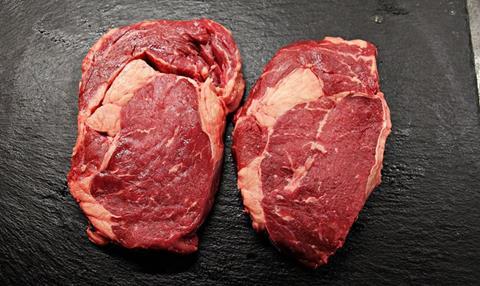Since mid-to-late May, prime cattle prices have been coming under pressure at Scottish abattoirs, with R4L grade steers falling 2.8% from a peak of 511.8p/kg in the week ending 20th May to 497.3p/kg in the week ending 24th June.

Nevertheless, prices still held a 9% increase over the same week of 2022 and a 24% lead over the five-year average, according to the latest market commentary from Quality Meat Scotland (QMS).
"One factor at play is likely to have been a short-term seasonal lift in supply, with the downwards pricing pressure not just local to Scotland," said Iain Macdonald, market intelligence manager at QMS. “While prime cattle slaughter in Scotland has been affected by supply chain challenges, numbers at the price reporting abattoirs in England and Wales have been above the year-to-date average in six of the past seven weeks and were at their third highest of the year in the week to 24th June.”
However, with the spring-2021 calf crop now well over two years of age, weekly slaughter availability is set to tighten over the summer, partially offset by the spring-2022-born young bulls, he said.
As well as a seasonal lift in availability, prime cattle numbers on farm across GB showed a year-on-year increase in the 1st April BCMS cattle population data. Though numbers in Scotland continued to show a significant decrease on a year earlier, down 2.5%, this was more than offset by a 2.3% uplift in England and Wales.
After factoring in a 6% increase at GB level in the 24-30 month age group, which accounted for the largest share of prime cattle slaughter in the second quarter of the year in 2022, the short-term upwards impact on availability for slaughter is likely to have been stronger.
"Where inputs have been bought on contract or in compound form, falling commodity prices will take longer to have a positive impact on margins."
Iain Macdonald
Iain said: “It should also be noted that while slaughter in England and Wales does appear to have risen this year, it has not increased by as much as expected given the sharp reduction in Scotland and the likelihood of increased cross-border movements for slaughter in Q2. This could point to a build-up of cattle on farms.
“Competition between processors for cattle has also reportedly softened due to demand-side pressures, with some of the lower value parts of the carcase becoming more challenging to sell into the food manufacturing sector. Cow prices are a good indicator of the manufacturing beef trade and they have also fallen by around 2-3% from their May peak, at a time of year when prices tend to stabilise around their seasonal highs with slaughter volumes well below their annual peak.”
Competitive pressures may also have been influencing the market in recent weeks, with Scottish and GB cattle prices reopening a significant margin over EU levels. In the Irish Republic, R3 steer prices have fallen 4.3% since the end of April, resulting in Scottish R4L steer prices opening a 14% lead at a time of year when Irish prices are often seasonally high. A rising sterling has added to the competitive pressures, with the Irish price fall a steeper 7% when quoted in pence per kilo.
Iain added: “The Scottish R4L steer price lead over the EU R3 young bull average has also widened, reaching 18%, having averaged around 4% in 2022. Interestingly, the softening of the EU beef market has come despite supply remaining tight this year, suggesting a weakening of demand. In the first quarter of 2023, EU beef production fell by 3.7% year-on-year, with data from the 17 member states to report April figures to Eurostat pointing to an acceleration of this decline towards 5%.”
Softening demand in certain markets

Meanwhile, a rising sterling has also reduced competitiveness against non-EU beef. Reports from the US point to some softening of demand in Asian markets. These external pressures may have reduced import and export prices, particularly for price sensitive lower value cuts.
Iain said: “A further variable which may have been having some influence is the reduction in global commodity prices, which has been reducing spot prices for a range of inputs. If some of the upturn in cattle prices over the past two years reflected rising input cost pressures faced by producers, the reversal in commodity prices may now be filtering through to cattle prices.
“In the UK, this fall in commodity prices has been added to by a rise in sterling against the US dollar. Feed wheat and barley have been trading 30-40% lower than last year’s levels in June and back towards where they had been in mid-2021. Meanwhile, spot energy, fuel and fertiliser prices are also well below their peak. Clearly however, where inputs have been bought on contract or in compound form, falling commodity prices will take longer to have a positive impact on margins.”
What does the future hold?
Looking forward to the second half of the year, prime cattle availability is expected to remain below 2022 levels in Scotland, though the pace of decline is set to soften towards 1-2% from above 4% in the first half. Meanwhile, south of the border, the pace of year-on-year increase is expected to soften to 1-2% in the second half, once the large increase at 24-30 months in April works its way out of the system, while a continuing increase at 18-24 months in April is partially offset by a reduction at 12-18 months.
For store cattle, availability is set to remain tight in autumn 2023, with numbers under a year old in April unchanged on a year earlier in Scotland, while being down 0.8% at GB level. A reduction in young cattle in England and Wales is set to maintain strong demand for Scottish-born calves from finishers based in England.
Iain added: “Looking longer-term, availability for slaughter is likely to be slightly lower in 2024 across GB, based on reductions in April 2023 for cattle aged under 18 months. Meanwhile, early signs from the 2023 spring calf crop are that numbers have held up more than suggested by the contraction in the breeding herd, pointing to a smaller reduction in supply in late 2024 and early 2025 than previously anticipated.
"While the number of beef-sired females over 30 months of age on Scottish farms was down by 3.6% year-on-year in April, beef sired registrations in the first third of the year were only marginally behind 2022 levels, while total registrations were down less than 1%. At GB level, registrations were down by 1.2% year-on-year in the January to April period.”
This story was originally published on a previous version of the Meat Management website and so there may be some missing images and formatting issues.















